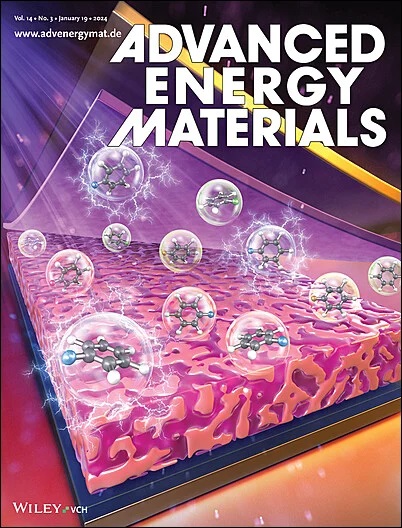通过二磺化配体螯合实现高稳定性碱性全铁氧化还原流动电池
IF 24.4
1区 材料科学
Q1 CHEMISTRY, PHYSICAL
引用次数: 0
摘要
本文章由计算机程序翻译,如有差异,请以英文原文为准。

Highly Stable Alkaline All-Iron Redox Flow Batteries Enabled by Disulfonated Ligands Chelation
Alkaline all-iron flow batteries possess intrinsic safety and low cost, demonstrating great potential for large-scale and long-duration energy storage. However, their commercial application is hindered by the issue of capacity decay resulting from the decomposition of iron complexes and ligand crossovers. In this paper, an robust anolyte Fe(TEA-2S) is reported, which is formed by chelating iron ions with the sulfonate-enriched ligand (TEA-2S) in alkaline environment. By skillfully designing the ligands, the binding energy of the iron complexes increases and ligand crossovers are suppressed, making the iron complexes highly stable in the charge–discharge cycles. Alkaline all-iron flow batteries coupling with Fe(TEA-2S) and the typical iron-cyanide catholyte perform a minimal capacity decay rate (0.17% per day and 0.0014% per cycle), maintaining an average coulombic efficiency of close to 99.93% over 2000 cycles along with a high energy efficiency of 83.5% at a current density of 80 mA cm−2. In addition, Fe(TEA-2S) exhibits high solubility of up to 1.85 м (with a theoretical capacity of up to 49.58 Ah L−1), even at low temperatures as extreme as −30 °C. This work demonstrates a promising pathway toward achieving long-duration and large-scale energy storage.
求助全文
通过发布文献求助,成功后即可免费获取论文全文。
去求助
来源期刊

Advanced Energy Materials
CHEMISTRY, PHYSICAL-ENERGY & FUELS
CiteScore
41.90
自引率
4.00%
发文量
889
审稿时长
1.4 months
期刊介绍:
Established in 2011, Advanced Energy Materials is an international, interdisciplinary, English-language journal that focuses on materials used in energy harvesting, conversion, and storage. It is regarded as a top-quality journal alongside Advanced Materials, Advanced Functional Materials, and Small.
With a 2022 Impact Factor of 27.8, Advanced Energy Materials is considered a prime source for the best energy-related research. The journal covers a wide range of topics in energy-related research, including organic and inorganic photovoltaics, batteries and supercapacitors, fuel cells, hydrogen generation and storage, thermoelectrics, water splitting and photocatalysis, solar fuels and thermosolar power, magnetocalorics, and piezoelectronics.
The readership of Advanced Energy Materials includes materials scientists, chemists, physicists, and engineers in both academia and industry. The journal is indexed in various databases and collections, such as Advanced Technologies & Aerospace Database, FIZ Karlsruhe, INSPEC (IET), Science Citation Index Expanded, Technology Collection, and Web of Science, among others.
 求助内容:
求助内容: 应助结果提醒方式:
应助结果提醒方式:


